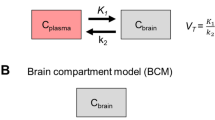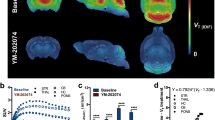Abstract
Purpose
P-glycoprotein (Pgp) is an efflux protein found amongst other locations in the blood–brain barrier. It is important to investigate the effect of Pgp modulation on clinically used brain tracers, because brain uptake of the tracer can be altered by blocking of the Pgp efflux transporter. The function of Pgp can be blocked with cyclosporin A.
Methods
We investigated the effect of cyclosporin A administration on the biodistribution of [123I]R91150 in rodents, and the effect of Pgp blocking on the quality of multipinhole μSPECT imaging with [123I]R91150. The influence of increasing doses of cyclosporin A on the brain uptake of [123I]R91150 was investigated in NMRI mice. A biodistribution study with [123I]R91150 was performed in male Sprague-Dawley rats pretreated with cyclosporin A and not pretreated. Brain uptake of [123I]R91150 after cyclosporin A injection was compared to the brain uptake in untreated animals, and a displacement study with ketanserin was performed in both groups. A multipinhole μSPECT brain imaging study was also performed using a Milabs U-SPECT-II camera in male Sprague-Dawley rats. To exclude the effect of possible metabolites, a metabolite study was also performed.
Results
At the highest cyclosporin A dose (50 mg/kg), a sevenfold increase in brain radioactivity concentration was observed in NMRI mice. Also, a dose-response relationship was established between the dose of cyclosporin A and the brain uptake of [123I]R91150 in mice. Compared to the control group, a five-fold increase in [123I]R91150 radioactivity concentration was observed in the brain of Sprague-Dawley rats after cyclosporin A treatment (50 mg/kg). Radioactivity concentration in the frontal cortex increased from 0.24±0.0092 to 1.58±0.097% injected dose per gram of tissue after treatment with cyclosporin A (at the 1-h time-point). Blood radioactivity concentrations did not increase to the same extent. The cortical activity was displaced by administration of ketanserin. A metabolite study confirmed that there was no increased metabolism of [123I]R91150 due to cyclosporin A. The visual quality of multipinhole μSPECT images with [123I]R91150 in Sprague-Dawley rats improved markedly after cyclosporin A pretreatment.
Conclusion
From the results obtained in the biodistribution studies, it can be concluded that [123I]R91150 is a substrate for Pgp in rodents. A relationship between the administered dose of cyclosporin A and the increase in [123I]R91150 brain radioactivity concentration was established. The overall quality of our multipinhole μSPECT images with [123I]R91150 in rats improved markedly after pretreatment of the animals with cyclosporin A.





Similar content being viewed by others
References
Heinrich T, Böttche H, Prücher H, Gottschlich R, Ackermann K-A, van Amsterdam C. 1-(1-Phenethylpiperidin-4-yl)-1-phenylethanols as potent and highly selective 5-ht2A antagonists. Chem Med Chem 2006;1:245–55.
Barnes NM, Sharp T. A review of central 5-HT receptors and their function. Neuropharmacology 1999;38:1083–152.
Kristiansen H, Elfving B, Plenge P, Pinborg LH, Gillings N, Knudsen GM. Binding characteristics of the 5-HT2A receptor antagonists altanserin and MDL 100907. Synapse 2005;58:249–57.
Lundkvist C, Halldin C, Ginovart N, Nyberg S, Swahn CG, Carr AA, et al. [C-11]MDL 100907, a radioligand for selective imaging of 5-HT2A receptors with positron emission tomography. Life Sci 1996;58:L187–92.
Mathis CA, Mahmood K, Huang Y, Simpson NR, Gerdes JM, Price JC. Synthesis and preliminary in vivo evaluation of [C-11]MDL 100907: a potent and selective radioligand for the 5-HT2A receptor system. Med Chem Res 1996;6:1–10.
Catafau AM, Danus M, Bullich S, Llop J, Perich J, Cunningham VJ, et al. Characterization of the SPECT 5-HT2A receptor ligand I-123-R91150 in healthy volunteers: Part 1 – Pseudoequilibrium interval and quantification methods. J Nucl Med 2006;47:919–28.
Catafau AM, Danus M, Bullich S, Nucci G, Llop J, Abanades S, et al. Characterization of the SPECT 5-HT2A receptor ligand I-123-R91150 in healthy volunteers: part 2 – ketanserin displacement. J Nucl Med 2006;47:929–37.
Marner L, Knudsen GM, Madsen K, Haugbol S, Vogel A, Holm S, et al. Longitudinal assessment of cerebral 5-HT2A receptors in normal volunteers. An [18F]-altanserin PET study. Neuroimage 2006;31:T101.
Mintun MA, Sheline YI, Moerlein SM, Vlassenko AG, Huang Y, Snyder AZ. Decreased hippocampal 5-HT2A receptor binding in major depressive disorder: in vivo measurement with [18F]altanserin positron emission tomography. Biol Psychiatry 2004;55:217–24.
Rosier A, Dupont P, Peuskens J, Bormans G, Vandenberghe R, Maes M, et al. Visualisation of loss of 5-HT2A receptors with age in healthy volunteers using [F-18]altanserin and positron emission tomographic imaging. Psychiatry Res 1996;68:11–22.
Sheline YI, Mintun MA, Moerlein SM, Vlassenko AG, Xue F, Snyder AZ. Decreased hippocampal 5-HT2A receptor binding in medication naive major depression measured with [18F] altanserin positron emission tomography. Biol Psychiatry 2003;53:10S.
de Vries EFJ, Kortekaas R, van Waarde A, Dijkstra D, Elsinga PH, Vaalburg W. Synthesis and evaluation of dopamine D-3 receptor antagonist C-11-GR218231 as PET tracer for P-glycoprotein. J Nucl Med 2005;46:1384–92.
Ishiwata K, Kawamura K, Yanai K, Hendrikse NH. In vivo evaluation of P-glycoprotein modulation of 8 PET radioligands used clinically. J Nucl Med 2007;48:81–7.
Syvanen S, Blomquist G, Sprycha M, Hoglund AU, Roman M, Eriksson O, et al. Duration and degree of cyclosporin induced P-glycoprotein inhibition in the rat blood-brain barrier can be studied with PET. Neuroimage 2006;32:1134–41.
van Eerd JEM, De Geus-Oei LF, Oyen WJG, Corstens FHM, Boerman OC. Scintigraphic imaging of P-glycoprotein expression with a radiolabelled antibody. Eur J Nucl Med Mol Imaging 2006;33:1266–72.
Gottesman MM, Pastan I. Biochemistry of multidrug-resistance mediated by the multidrug transporter. Annu Rev Biochem 1993;62:385–427.
Hendrikse NH, Frans EJ, Van der Graaf WTA, Vaalburg W, De Vries EGE. Visualization of multidrug resistance in vivo. Eur J Nucl Med 1999;26:283–93.
Weiss J, Kerpen CJ, Lindenmaier H, Dormann SM, Haefeli WE. Interaction of antiepileptic drugs with human P-glycoprotein in vitro. J Pharmacol Exp Ther 2003;307:262–7.
Herzog CE, Tsokos M, Bates SE, Fojo AT. Increased Mdr-1/P-Glycoprotein expression after treatment of human colon-carcinoma cells with P-glycoprotein antagonists. J Biol Chem 1993;268:2946–52.
van Asperen J, Schinkel AH, Beijnen JH, Nooijen WJ, Borst P, van Tellingen O. Altered pharmacokinetics of vinblastine in Mdr1a P-glycoprotein-deficient mice. J Natl Cancer Inst 1996;88:994–9.
Liow JS, Lu SY, McCarron JA, Hong JS, Musachio JL, Pike VW, et al. Effect of a P-glycoprotein inhibitor, cyclosporin A, on the disposition in rodent brain and blood of the 5-HT1A receptor radioligand, [C-11](R)-(-)-RWAY. Synapse 2007;61:96–105.
Elsinga PH, Hendrikse NH, Bart J, van Waarde A, Vaalburg W. Positron emission tomography studies on binding of central nervous system drugs and P-glycoprotein function in the rodent brain. Mol Imaging Biol 2005;7:37–44.
Hendrikse NH, Schinkel AH, De Vries EGE, Fluks E, Van der Graaf WTA, Willemsen ATM, et al. Complete in vivo reversal of P-glycoprotein pump function in the blood-brain barrier visualized with positron emission tomography. Br J Pharmacol 1998;124:1413–18.
Lee YJ, Maeda J, Kusuhara H, Okauchi T, Inaji M, Nagai Y, et al. In vivo evaluation of P-glycoprotein function at the blood-brain barrier in nonhuman primates using [C-11]verapamil. J Pharmacol Exp Ther 2006;316:647–53.
Joseph B, Bhargava KK, Malhi H, Schilsky ML, Jain D, Palestro CJ, et al. Sestamibi is a substrate for MDR1 and MDR2 P-glycoprotein genes. Eur J Nucl Med Mol Imaging 2003;30:1024–31.
Kiyono Y, Yamashita T, Doi H, Kuge Y, Katsura T, Inui KI, et al. Is MIBG a substrate of P-glycoprotein? Eur J Nucl Med Mol Imaging 2007;34:448–52.
Baeken C, D’haenen H, Flamen P, Mertens J, Terriere D, Chavatte K, et al. I-123-5-I-R91150, a new single-photon emission tomography ligand for 5-HT2A receptors: influence of age and gender in healthy subjects. Eur J Nucl Med 1998;25:1617–22.
Mertens J, Terriere D, Sipido V, Gommeren W, Janssen PMF, Leysen JE. Radiosynthesis of a new radioiodinated ligand for serotonin-5Ht(2)-receptors, a promising tracer for gamma-emission tomography. J Labelled Compd Radiopharm 1994;34:795–806.
Takano A, Kusuhara H, Suhara T, Ieiri I, Morimoto T, Lee YJ, et al. Evaluation of in vivo P-glycoprotein function at the blood-brain barrier among MDR1 gene polymorphisms by using C-11-verapamil. J Nucl Med 2006;47:1427–33.
Katoh M, Suzuyama N, Takeuch T, Yoshitomi S, Asahi S, Yokoi T. Kinetic analyses for species differences in P-glycoprotein-mediated drug transport. J Pharm Sci 2006;95:2673–83.
Author information
Authors and Affiliations
Corresponding author
Rights and permissions
About this article
Cite this article
Blanckaert, P., Burvenich, I., Staelens, S. et al. Effect of cyclosporin A administration on the biodistribution and multipinhole μSPECT imaging of [123I]R91150 in rodent brain. Eur J Nucl Med Mol Imaging 36, 446–453 (2009). https://doi.org/10.1007/s00259-008-0968-x
Received:
Accepted:
Published:
Issue Date:
DOI: https://doi.org/10.1007/s00259-008-0968-x




